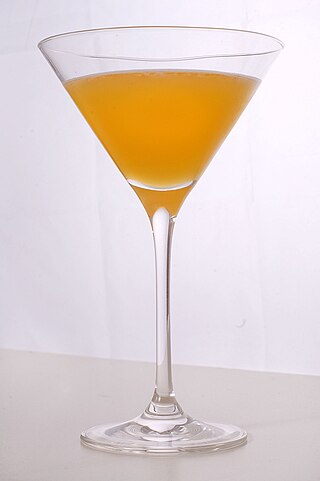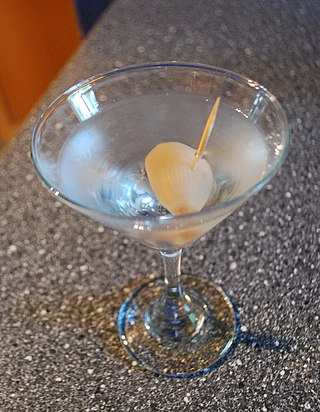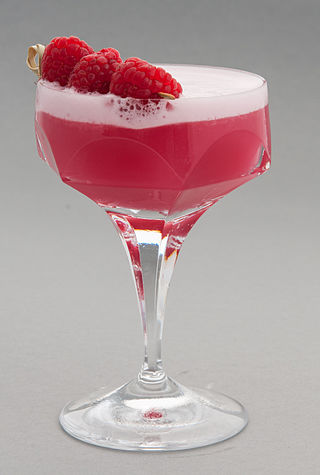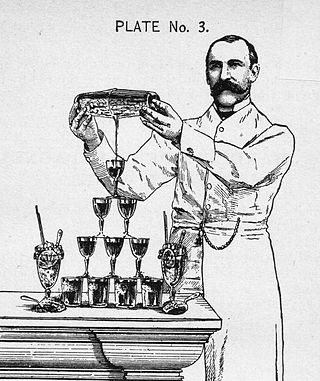
A Manhattan is a cocktail made with whiskey, sweet vermouth, and bitters. While rye is the traditional whiskey of choice, other commonly used whiskies include Canadian whisky, bourbon, blended whiskey, and Tennessee whiskey. The cocktail is usually stirred with ice then strained into a chilled cocktail glass and garnished traditionally with a maraschino cherry. A Manhattan may also be served on the rocks in a lowball glass.

Vermouth is an aromatized fortified wine, flavoured with various botanicals and sometimes colored. The modern versions of the beverage were first produced in the mid to late 18th century in Turin, Italy. While vermouth was traditionally used for medicinal purposes, it was later served as an apéritif, with fashionable cafés in Turin serving it to guests around the clock. In the late 19th century, it became popular with bartenders as a key ingredient for cocktails, such as the martini, the Manhattan, the Rob Roy, and the Negroni. In addition to being consumed as an apéritif or cocktail ingredient, vermouth is sometimes used as an alternative to white wine in cooking.

The martini is a cocktail made with gin and vermouth, and garnished with an olive, a lemon twist, or both. Over the years, the martini has become one of the best-known mixed alcoholic beverages. A common variation, the vodka martini, uses vodka instead of gin for the cocktail's base spirit.

The negroni is a cocktail, made of equal parts gin, vermouth rosso, and Campari, generally served on the rocks, and commonly garnished with an orange slice or orange peel. It is considered an apéritif.

The hanky panky is a cocktail made from gin, sweet vermouth, and Fernet-Branca. It is a variation on the sweet martini, or Martinez, made distinctive by the Fernet-Branca, a bitter Italian digestivo. It was created by Ada "Coley" Coleman, head bartender at the Savoy Hotel, London.

An apple martini is a cocktail containing vodka and one or more of apple juice, apple cider, apple liqueur, or apple brandy. Although the drink contains no vermouth by default, the term "apple martini" is consistent with the trend of calling any straight liquor in a martini glass a "martini," such as the saketini or other variations.

"Shaken, not stirred" is how Ian Fleming's fictional British Secret Service agent James Bond prefers his martini cocktail.

The Bronx is a cocktail. It is essentially a Perfect Martini with orange juice added. It was ranked number three in "The World's 10 Most Famous Cocktails in 1934" behind the Martini (#1) and the Manhattan (#2). In the 1934 movie "The Thin Man", the lead actor compared the methods for shaking the Manhattan, the Bronx and the Martini.

The Gibson is a mixed drink made with gin and dry vermouth, and often garnished with a pickled onion. In its modern incarnation, it is considered a cousin of the ubiquitous martini, distinguished mostly by garnishing with an onion instead of an olive. But the earliest recipes for a Gibson – including the first known recipe published in 1908 by Sir David Austin – are differentiated more by how they treat the addition of bitters.

A bijou is a mixed alcoholic drink composed of gin, vermouth, and chartreuse. This cocktail was invented by Harry Johnson, "the father of professional bartending", who called it bijou because it combined the colors of three jewels: gin for diamond, vermouth for ruby, and chartreuse for emerald. An original-style bijou is made stirred with ice as Johnson's 1900 New and Improved Bartender Manual states "mix well with a spoon and serve." This recipe is also one of the oldest in the manual, dating back to the 1890s.

A Bacon Martini, also known as bacontini, pig on the rocks or a bloody bacon martini, is a cocktail that consists of bacon-infused vodka served with a garnish that can include strips of bacon, bacon bits, or olives. Variants may include the addition of Bloody Mary mix. Although not a vodka martini, which consists of vodka and vermouth, the term "bacon martini" is consistent with the trend of calling any straight liquor in a martini glass a "martini," such as the saketini or other variations.

A Clover Club cocktail is a shaken cocktail consisting of gin, lemon juice, raspberry syrup, and egg white. The egg white acts as an emulsifier, forming the drink's characteristic foamy head.
Richard Arthur Bradsell was a British barman noted for his innovative work with cocktails, including the creation of many new drinks now considered to be modern classics. The Observer described him as the "cocktail king", while Waitrose Food Illustrated compared him to celebrity chefs and the San Francisco Chronicle credited him with "single-handedly (changing) the face of the London cocktails scene in the 1980s."

Death in the Afternoon, also called the Hemingway or the Hemingway Champagne, is a cocktail made up of absinthe and Champagne, invented by Ernest Hemingway. The cocktail shares a name with Hemingway's 1932 book Death in the Afternoon, and the recipe was published in So Red the Nose, or Breath in the Afternoon, a 1935 cocktail book with contributions from famous authors. Hemingway's original instructions were:
"Pour one jigger absinthe into a Champagne glass. Add iced Champagne until it attains the proper opalescent milkiness. Drink three to five of these slowly."
Colin Peter Field is a bartender and author who has been ranked as best bartender in the world by Forbes and Travel + Leisure magazines. He is the head bartender at the Hemingway Bar of the Hôtel Ritz Paris, voted Best of the Best Bar in the World by Virtuoso in Las Vegas in 2016, and has invented several drinks, such as the Picasso Martini, Highland Cream, Serendipity and Clean Dirty Martini. He is involved in the training of students for bartending in France and in Switzerland, and has authored the books The Cocktails of the Ritz Paris and Cocktails, A Simple Story.

The espresso martini, also known as a vodka espresso, is a cold caffeinated alcoholic drink made with espresso, coffee liqueur, and vodka. It is not a true martini as it contains neither gin nor vermouth, but is one of many drinks that incorporate the term martini into their names.

Harry Johnson was an American bartender who owned and operated saloons across the US in the late 19th century and the early 20th century. He is best known for the New and Improved Bartenders' Manual, an influential book that contained many original cocktail recipes, as well as the first written recipes of such cocktails as the marguerite and a version of the martini. Perhaps even more importantly, it was the first book to offer bar management instructions. Johnson opened the first ever consulting agency for bar management. Imbibe magazine has called him one of the most influential cocktail personalities of the last 100 years, and he has been called "the father of professional bartending".

The Martinez is a classic cocktail that is widely regarded as the direct precursor to the Martini. It serves as the basis for many modern cocktails, and several different versions of the original exist. These are generally distinguished by the accompaniment of either Maraschino or Curacao, as well as differences in gin or bitters.

The craft cocktail movement is a social movement spurred by the cocktail renaissance, a period of time in the late 20th and early 21st century characterized by a revival and re-prioritization of traditional recipes and methods in the bar industry, especially in the United States. The renaissance was followed by innovation and new techniques, and the movement has spread globally, now forming part of global cuisine.


















